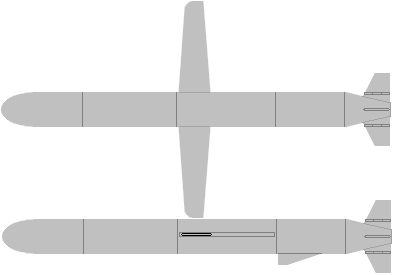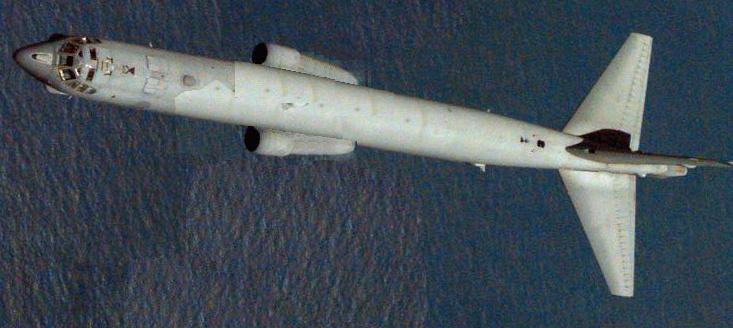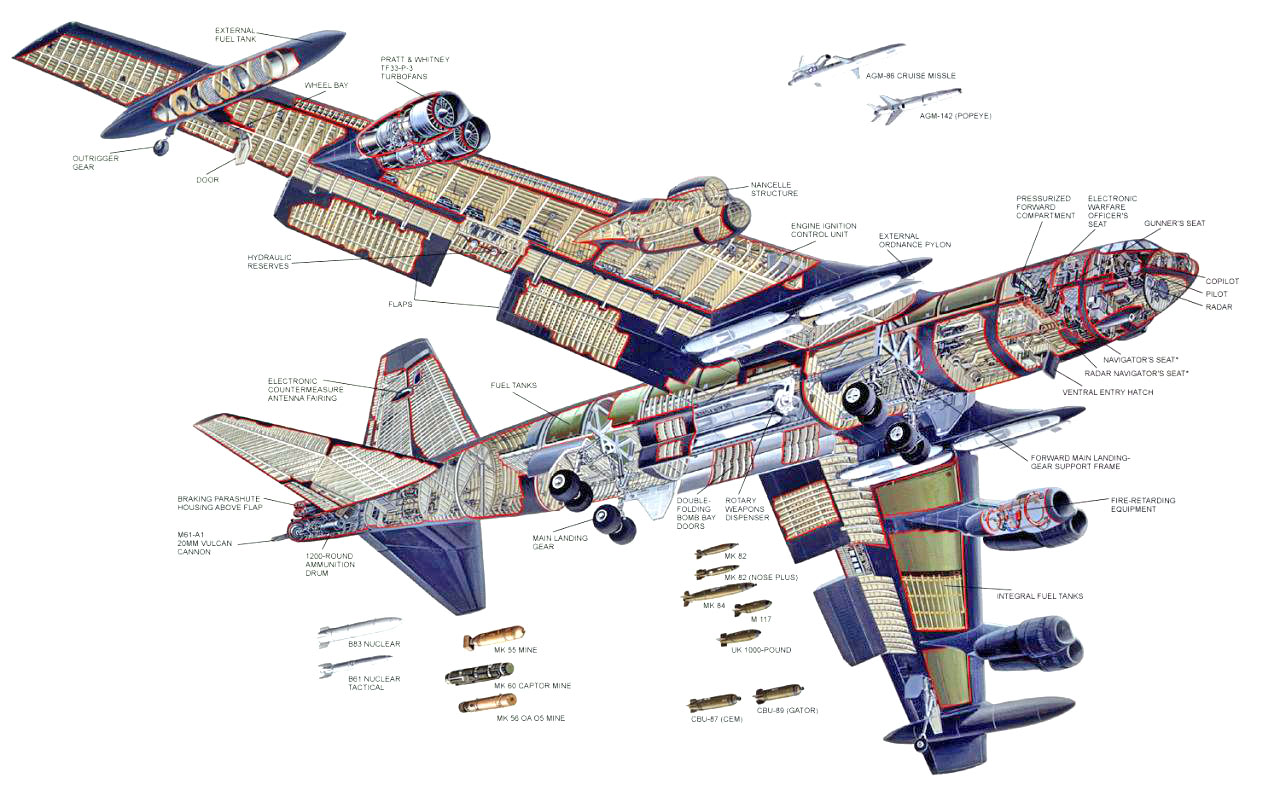 |  | ||
| When the REF deployed to Tirol, they took with them about a dozen B-52 Stratofortress Bombers, with the expectation that there 'may' be a ground campaign; How right they The only reason the four of them didn't end up in real trouble for what they'd done was that they did attempt to use the bomber, dubbed "Curious George," to thWart TR EDWARDS' coup attempt. Their mission, to seed the path of EDWARDS' ship with bombs, was a failure, since the bombs they had available were simply inadequate to the task at hand, but it did have the effect of showing what the bomber could do- Curious George could even have assassinated EDWarDS. Curious George was grounded permanently after that, of course, but the project drew interest for various parties in the REF. The airframe of Curious George was repaired, studied, and reverse engineered. The result was the B-104 Galaxy Bomber, which is now the heaviest dedicated non-spacefold/FTL capable bomber in the UGC's inventory. The B-104 has two bomb bays, each consisting of 2 rotating drums that hold 50 bombs, either MT-28 Reflex, MT-32 Nuclear, or MT-35 High Explosive; Typically the MT-35's are used. All three can be JDAMS, Laser, or radio accurized. Additionally, any two drums can be removed and replaced with two Free Ordnance Attack Bodies, or FOAB's (aka "Father Of All Bombs"), massive ground-penetrators used primarily to destroy fixed installations. The B-104 is also capable of defending itself, with twin forward, one dorsal and one ventral, and an aft anti-aircraft laser battery. This, combined with a superior, nearly ship-grade shielding array, makes the B-104 an unattractive target to all but the most insane fighter pilots; It also has a bounty (all malcontent faction leaders offer one, ranging from 50,000 credit to 50 million credit for each B-104 shot down). Airframe: Curious George was literally 2 B-52's grafted together is a crisis. The B-104 uses the same basic concept, though Curious George's rather less than reliable welds have been replaced by a single piece of steel fabricated for that purpose at the factory (or rather, 8 major such pieces, plus dozens of smaller ones). Flight Systems: The B-104 doesn't have wings; They don't need them. Curious George used scrounged Tiresian anti-gravity pods (grav pod technology had not been taken from the Atorians, as that War was still a few years off), which were upgraded to grav opds (after the Atorian War). Stubby winglets 'can' be fitted onto the craft to support external ordance (such as FOABs or additional standard ordinance), but this isn't a common practice. There specifically is a regulation that prevents Commanding Officers and piltos from refusing to use the winglets if circumstances require them, however. Life Support: Curious George was used in space in a manner so far beyond the normal for a B-52 as to be mind-boggling; The ships simply was NOT designed for this. As such, her flight crew had to wear regular spacesuits to complete their mission (which itself almost led to failure outright). Purpose built B-104's however are built for space flight, with a properly pressurized cabin and access tube (and engine access cross-connect tubes). There is no gravity aft of the command deck and forward of aft cabin, and crews are actually quite happy about that; Fire works very differently in gravity (and much differently still in artificial or focused gravity), and in any case no gravity allows them to access the rest of the craft very quickly in an emergency. The three main compartments, the Command Deck, Access Tube/Cross Access Tubes, and Aft Cabin can be independently sealed in an emergency, and crews still fly with spacesuits on, but in lowered readiness (just like Veritech pilots and ship's crews). Powerplants: Quad VRA-17 Dual Phase hydrocell scramjets, each generating 22.210 lbs at 621 ggH, can run for 60 flight hours before requiring refueling (can be refueled in flight). The VRA-17 started life as a plasma rocket, but the advent of Dual Phase Aeration made the B-104 vastly more flexible, taking air in while in atmosphere and storing it when in vacuum. Weapons System: The B-104 drops bombs. It's a bomber. That's it's job. Two bomb bays holding up to 50 bombs each make up the majority of the craft's weapons systems, though the bomb bay rotators can be switched out for a pair of FOABs for major anti-bunker missions. "Clip on" winglets can double the craft's bomb load (triple it, in the case of FOABs). Defensive Systems: The bombers carry an array of defensive equipment, most aimed at the bomber's primary threat, missiles; A full-force barrier field protect the bomber from initial attack, while anti-aircraft/fighter batteries can provide some protection. Targeted sand casters are also available, which can blind and even befuddle missiles (and occasionally fighters as well, since it really does hit like a brick flying as Mach speeds, which is about what it is). While unlikely to do any "real" damage to a fighter, and not really to destroy a missile, it can throw a fighter off for a few seconds, and "ring the bells" of a missile, causing it to go off who-knows-where. Damage Control Systems: Each engine has its own fire suppression system, and is itself in a contained, semi-pressurized nacelle, so that in the event of fire or other damage the engine's fuel supply can be cut off entirely and air supply mostly strangled; If a lack of fuel doesn't kill the fire, then converting all the air to smoke will suffocate it in short order (that is, if the halon didn't kill it first). The engines can be reached, in their entirety, from the inside of the bomber; In fact, they can rotate horizontally when not on line for in-flight repair, a fact not lost on pilots and crewmen, as this detail alone is accredited with dozens of B-104's returning safely to "a" base (not always their own) during the opening month of the Atorian War alone. The engines must be locked back in place to operate, but this is a minor inconvenience that the crews are very happy to deal with, considering it's literally the smallest craft that allows in-flight repairs, and the only craft in UGC inventory with a feature quite like that. The Main Access Tube can be sealed in the event of catastrophic damage; In many cases, Cross Access Tubes can also be sealed independently of the rest of the craft, allowing the main access to remain pressurized (this is not always the case). In their normal kit, each B-104 keeps enough spare parts to rebuild at bare minimum efficiency one engine, along with scrounging parts from other disabled engines to return one to operational condition, allowing the craft to return to "a" base safely. The HUD for the B-104 has a constant Damage Indicator showing anyone on the command deck where any damage is, what type, and how bad; It's in the pilot's window, upper right hand corner. The computer can also be set to "simulate" damage for drills. Avionics: The B-104's avionics aren't really all that spectacular; They're barely more advanced than a cargo plane, with the difference that a cargo plane's flight control computer would tell the crew to drop pallets, whereas the B-104's tells the crew when to drop bombs. In fact, the computer will do that for the crew, but in flight the crew must authorize release about 2 minutes before the drop point, or else manually release and hope they've calculated correctly. Current And Future Status: The B-104 was developed at a time when the REF had few alternatives, and while they served admirably during that time the practical use for them waned quite quickly after the Atorian War; A lack of proper interest in maintaining the fleet led to an atrophy from six dozen bombers to just 10, with three grounded at any given time. The ASF has been forced to fabricate replacement parts themselves, as no commercial vendor will accept the contract (the profit margin is far too low). The ASF at this time wants to take the B-104’s off line entirely, but has been stymied in those efforts for lack of a replacement. They have requested ACCLAMATOR II-Class Orbital Bombardment variants, but these requests have not been approved. Model Number: B-104 Vehicle Type: Strategic Bomber. Crew: 4. M.D.C. by Location: | |||
| *** Fuselage- Cockpit- ** Elevators (2)- | 280 120 40 each | ** Rudders (2)- *** Engines (2)- | 40 each 120 each |
| Notes: ** Destruction of rudders or one elevator will still allow the plane to be controlled by the varying of power levels of the engines but the fighter has a penalty of -10 to dodge, and a -30% penalty to all piloting rolls. Destruction of both of the elevators will leave the plane uncontrollable and pilot must eject to survive. *** The destruction of one engine will reduce the fighters top speed by half and give the pilot a -2 penalty to dodge as well as giving a 10% penalty to piloting. Destruction of both engines will cause the aircraft to crash. Pilot may attempt an emergency landing or pilot can choose to eject. **** Depleting the M.D.C. of the main body will shut the Aircraft down completely, rendering it useless and causing it to crash if in flight. Speed and Statistical Data: Despite the advent of advancing technologies, the B-104 really isn't all that different from the original airframe of the B-52 it came from; Only the longer fuselage, loss of wings, addition of grav pods and dual-phase hydrocell scramjets, and very slight avionic and mechanical changes; All told, really it's less than a 10% change, when one discounts the longer fuselage and no wings. | |||
| Driving on Ground (Taxiing): Less than one mile an hour safely. Flying: 210 MPH max. Range: Up to 60 hours continuously. Height: 20 feet. Fuselage Width: 8 feet. Ya, that's it. Wingspan: 16 feet overall. Length: 323 feet 8.75 inches (101.41585m). | Weight: 277.5 tons (249,750k). Power and Thrust System: Quad VRA-17 dual-phase hydrocell scramjets; Output: 22.210 lbs at 621 ggH each; Endurance: 60 flight hours before requiring refueling (can be refueled in flight). Flight System: Grav pods. Cargo: None- Just bombs. Cost and Availability: 22 millioncredit; Takes a year to build. Black Market Cost and Availability: Varies from 6 million to 600credit; Very rare, and VERY hot. | ||
| Weapon Systems: | |||
| 01. Standard Ordinance: The B-104 Bomber typically carries 200 bombs, either the MT-28 Reflex, MT-32 Nuclear, or MT-35 High Explosive. All three can be JDAMS, Laser, or radio accurized. MT-35 High Explosive: Hands down, this is the most common ordinance carried by B-104's, and routinely requested by ground pounders. Each one of these bombs, just one bomb by itself, is capable of flattening several blocks of high-rise buildings. Mega Damage: 1D4 times 20. Blast Radius: 2,000 feet. MT-28 Reflex: When the call is made for a WMD, it is always preferred that Reflex weaponry is used whenever possible. These are only used by order of a Task Force/Battle Force Commander. Mega Damage: 3D6 times 10. Blast Radius: 8 miles. Special: Unlike nuclear missiles, the Reflex bomb doesn't create radioactive fallout; It does create fallout, and lots of it, but once the fallout (dust) is settled, it's all over. 10 years or 10 minutes later, the area's perfectly safe- Provided the blast didn't create macroscopic particulates (which take years to settle, and often are as carcinogenic as radiation) or set everything within a 20 mile area on fire or any one of a dozen other possible, and highly undesirable, results. MT-32 Nuclear: There are, rarely, times when nuclear weapons are the proper response; This is typically in response to some sort of suicide run, such as a ram-ship, or the use of a nuclear or Reflex missile. Mega Damage: 3D6 times 10. Blast Radius: 10 miles plus twice that for heat damage and three times that for radiation damage. Special: Once the nuke is used, it releases radioactive fallout, making the area unsafe for any form of life for the next 50 years. Worse, the radiation can spread as far as the winds can blow the dust, or be spread to just about anywhere in space. Fortunately, if you stay 20 miles away for 48 hours the radiation becomes too diluted to be effective (ships in space are safe), and the radiation degrades too far by planet fall to be a risk to most life forms. Most life forms. Maximum Effective Range (all): Free-fall; Range is determined by drop height. Rate of Fire (all): Each drum can drop one bomb per bombardier's attacks per melee. Payload (all): 100 total. 02. Full-Force Variable Barrier Field: The B-104 has one of the best shielding system in the UGC's inventory, and is rigged to the weapons control systems to permit them to be dropped instantaneously with the activation of any weapon, meaning the shields are down of less than one second- Far too shot a period of time for any but the BEST of the best of the best fighter pilot to exploit. MDC: 150 per panel (900 total). Action Time: Instant. Payload: 900 total. | 03 Anti-Aircraft Laser Batteries: "Anti-Aircraft" is a bit of a misnomer; They're actually anti-missile defense batteries. It actually makes a great deal of sense; The missile doesn't have to be destroyed to be knocked off target, dazzled, have a control system fried and run off the wrong direction, or even prematurely detonated. Mega Damage: 1D6 times 5 per blast (five blasts per attack); Also has a 50% chance of confusing the missile (per above) on a direct hit. Maximum Effective Range: 8 miles. Rate of Fire: FIVE TIMES the Defense System operator's attacks per melee; Each time the gunner triggers the guns, it goes off five times. That, is the secret of the laser batteries effectiveness. Payload: Effectively unlimited.  Mega Damage: 3D6 times 100. Blast Radius: 1 mile, plus twice that for heat damage and three times that for radiation damage. Special: The FOAB can penetrate up to one-half mile underground, then detonate, causing a Richter 6.3 earthquake on average- This can do an additional 2D4 MD. The FOAB can also penetrate up to 200 MDC WITHOUT DETONATING, making it an ideal bunker buster. Maximum Effective Range: The bomb can glide up to three time the cruising height of bomber at time of release; The very small rocket motors (equal to a mini-missile's) is for course correction, not for forward propulsion. Rate of Fire: One missile per melee. Payload: Four total. | ||
| Features: | |||
|
| ||
| |||


